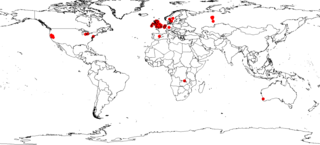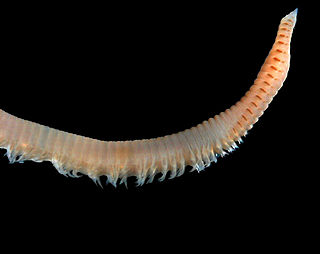
Genus is a taxonomic rank used in the biological classification of living and fossil organisms as well as viruses. In the hierarchy of biological classification, genus comes above species and below family. In binomial nomenclature, the genus name forms the first part of the binomial species name for each species within the genus.
The Calabria pine vole is a vole found in southern and central Italy initially described by Lehmann as a subspecies of M. savii. Genetic tests in the Calabrian region found, although similar, the X chromosome is larger than that of samples of M. savii found elsewhere in Italy and the Y chromosome is twice the size, leading Galleni in 1994 to designate M. brachycercus as a separate species.
The World Register of Marine Species (WoRMS) is a taxonomic database that aims to provide an authoritative and comprehensive list of names of marine organisms.

The Interim Register of Marine and Nonmarine Genera (IRMNG) is a taxonomic database which attempts to cover published genus names for all domains of life, from 1758 in zoology up to the present, arranged in a single, internally consistent taxonomic hierarchy, for the benefit of Biodiversity Informatics initiatives plus general users of biodiversity (taxonomic) information. In addition to containing just over 500,000 published genus name instances as at May 2023, the database holds over 1.7 million species names, although this component of the data is not maintained in as current or complete state as the genus-level holdings. IRMNG can be queried online for access to the latest version of the dataset and is also made available as periodic snapshots or data dumps for import/upload into other systems as desired. The database was commenced in 2006 at the then CSIRO Division of Marine and Atmospheric Research in Australia and, since 2016, has been hosted at the Flanders Marine Institute (VLIZ) in Belgium.

Achnanthidium is a genus of diatoms belonging to the family Achnanthidiaceae.
Abathymermis parva is a species of nematode belonging to the family Mermithidae.
Achtheres is a genus of arthropods belonging to the family Lernaeopodidae.
Corticeus is a genus of beetles belonging to the family Tenebrionidae.
Dahlica is a genus of moths belonging to the family Psychidae.
Darwinula is a genus of ostracods belonging to the family Darwinulidae.

Hypulus is a genus of beetles belonging to the family Melandryidae. The species of this genus are found in Europe and North America
Hylis is a genus of beetles belonging to the family Eucnemidae.

Licea pusilla is a species of slime mould in the family Liceidae, first described in 1797 by Heinrich Schrader, and is the type species of the genus, Licea. It was described from a specimen collected in Germany from rotten wood in a pine forest.

Scoloplos is a genus of annelids belonging to the family Orbiniidae.
Campanulinidae is a family of cnidarians belonging to the order Leptomedusae.

Anomalocardia is a genus of bivalves belonging to the family Veneridae.

Babesiidae is a family of protists belonging to the order Piroplasmida.
Lestonia is a genus of true bugs belonging to the monotypic family Lestoniidae.
Lobophytum batarum is a species of Devil's Hand Coral or Lobophytum found in the Pacific and Indian oceans.
Lobophytum pusillum is a coral species of the genus Lobophytum.







